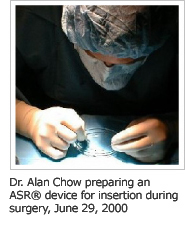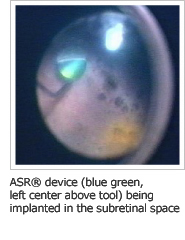NEWS: We are happy to have the Optobionics website back up. The original Optobionics Corporation has stopped operations. However, Dr. Chow has acquired the Optobionics name and the Artificial Silicon Retina (ASR) implants and will be reorganizing a new company under the Optobionics name.
If you are a patient with Retinitis Pigmentosa and would be interested in whether your eye condition may be responsive to ASR chip stimulation, you may contact us using the Contact Us tab or call us at (630) 858-4411. (Please be patient as it may take us a while to respond to you.)

 |
|
Implantation Surgery
|
|
The microsurgical procedure primarily consists of an ophthalmic operation called a vitrectomy and retinotomy.
The surgeon starts by making tiny incisions in the white part of the subject’s eye, through which instruments are inserted. Through these incisions, the vitreous gel in the middle of the eye is replaced with saline to allow un-impeded passage of the ASR chip implant. An opening is then made into the retina through which additional saline is injected. The saline lifts up a portion of the retina creating a small pocket in the “subretinal space” wide enough to accommodate the ASR chip.
The chip is then inserted into the subretinal space using a special instrument, much as one might slip a tiny coin into a pocket. Finally, the surgeon introduces air into the middle of the eye to gently push the retina back down over the implant. Over a period of one to two weeks, the air bubble is reabsorbed and replaced by fluids created within the eye.
The procedure usually takes about 2 hours. To date, the chip has been well tolerated in patients for up to 8 years. The total duration of ASR chip function is not known although it may be possible to replace or implant additional chips in a patient at a future date.
A paper containing results of the first six patients, entitled The Artificial Silicon Retina Microchip for the Treatment of Vision Loss From Retinitis Pigmentosa, has been published in the April 2004 issue of Archives of Ophthalmology.
The results of animal studies showing a neurotrophic rescue effect was published in the February 2007 issue of Investigative Ophthalmology & Visual Science.
|


|









